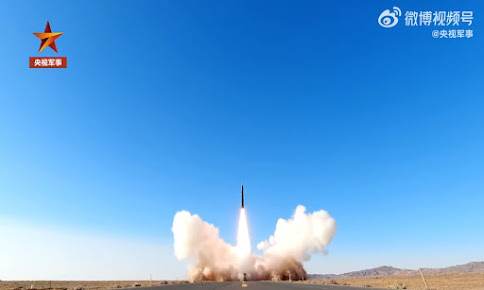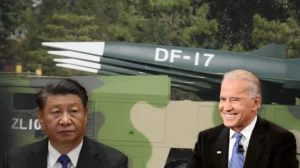Source : The Eurasian Times
 |
| A video celebrating August 1, the 95th anniversary of the founding of the Chinese People’s Liberation Army, released by China Central Television on July 30, 2022, displays the live-fire launch of a missile from a transporter erector launcher on a highway in a desert. The missile resembles the DF-17 hypersonic missile, which is publicly displayed at the National Day military parade on October 1, 2019 in Beijing. (Photo: Screenshot from China Central Television) |
China has recently been projecting power in the Indo-Pacific as tensions continue to rise in the region. In a move that could be construed as an all-new warning to its adversaries, the PLA has now released rare footage of its DF-17 hypersonic missile.
China released a video of what appeared to be a DF-17 missile launch for the first time, just before the Chinese People’s Liberation Army’s (PLA) 95th founding anniversary on August 1, Chinese-run state media Global Times reported.
China Central Television (CCTV) presented a documentary on July 30 called “The capabilities of the Chinese army revealed in 81 seconds”. In response to the special broadcast, the Chinese experts said the video showed the adaptability of the nearly impossible-to-intercept “aircraft carrier killer” weapon.
Military enthusiasts were particularly drawn to a scene in the video showing a live-fire launch of a missile from a transporter erector launcher on a highway in the desert. They claimed the missile resembled the DF-17 hypersonic missile, which was on display in public at the National Day military parade on October 1, 2019, in Beijing.
Previously, on July 28, the Chinese People’s Liberation Army (PLA) 80th Group Army posted a brief message on social media that garnered over 300,000 likes in just 12 hours. The message read, “we must bear in mind the fundamental responsibility of preparing for war and charge on the journey of a strong army.”
These developments come at a time when tensions have escalated between China and the US. A few days ago, Beijing even threatened a military response if the speaker of the US House of Representatives, Nancy Pelosi, visited the self-ruled island state of Taiwan.
Meanwhile, the US deployed its carrier strike group in the South China Sea. The USS Ronald Reagan and its strike group, which comprises a guided missile destroyer and a guided missile cruiser, left Singapore on July 25 for the South China Sea, according to Ship Tracking data released by a think tank.
In a statement to Reuters on July 28, US Navy’s Seventh Fleet confirmed the aircraft carrier’s deployment to the South China Sea region. In light of Chinese threats against Taiwan, the US military is reportedly working on contingency plans for any incident that may occur in case Pelosi visits Taiwan, as previously reported by EurAsian Times.
The deliberate reveal of China’s hypersonic weapon against the background of rising tensions could be aimed at sending a message to Taiwan as well as the United States.
The Big Hypersonic Reveal
Observers noted that if the missile depicted in the video is in fact, a DF-17, this would mark the first time China has made a video of a DF-17 launch available to the general public.
According to Song Zhongping, a Chinese military analyst and TV commentator, the new-type missile’s ability to launch from a highway in the desert proved that it is not dependent on a predetermined launch location. The missile is incredibly versatile because it may be launched autonomously at any time or location, according to Song.
Additionally, it means that foes will find it difficult to target this road-mobile missile before launch, according to analysts. Since the DF-17’s warhead is a hypersonic glider that travels faster than Mach 5 with an unexpected trajectory after launch, they claimed that it is virtually impossible to intercept for modern missile defense systems.
According to Yang Chengjun, a Chinese missile specialist, the missile that made its debut in 2019 will be essential in preserving China’s territorial integrity because areas including the South China Sea, the Taiwan Straits, and Northeast Asia are all within its striking range.
The DF-17 ballistic missile is mounted to a DF-ZF hypersonic glide vehicle. The missile is launched from a mobile transport-erector launcher and has a range of up to 2,500 km. As an HGV system, the DF-17 is fired from a regular rocket booster.
The missile separates after ascending to nearly exoatmospheric levels and employs a hypersonic glide vehicle to locate its target. The HGV is an effective tool for breaching complex enemy defenses in situations where more conventional systems would probably fail because of its extreme speed, lower trajectory, and mid-flight maneuverability.
The DF-17 renders the US network of missile defenses in East Asia obsolete, according to a previous report in the Global Times that read: “US air defense systems including THAAD, SM-3 and Patriot missiles deployed in South Korea, Japan, the island of Taiwan and on US warships will not work against the DF-17.”
On top of the already known formidable capabilities of the DF-17 hypersonic missiles, military expert Song made another revelation. He stated that the DF-17 can likely also hit slowly moving targets, referring to aircraft carriers. However, there has been little information related to a DF-17’s capability to attack carriers with precision.
It is pertinent to mention that Chinese experts have long argued that the PLA would not need a hypersonic missile like the DF-17 to strike Taiwan, for which they claim that the PLA’s older generation missiles are enough.







